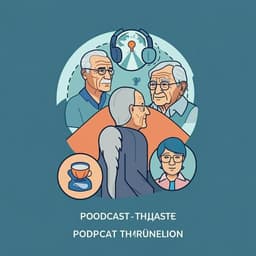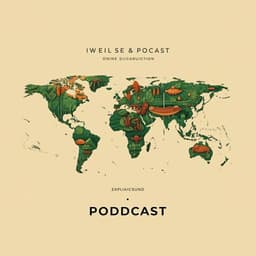
Biology
Social networks predict the life and death of honey bees
B. Wild, D. M. Dormagen, et al.
Discover how honey bees navigate their social networks and task allocation as they age! This cutting-edge research by Benjamin Wild, David M. Dormagen, Adrian Zachariae, Michael L. Smith, Kirsten S. Traynor, Dirk Brockmann, Iain D. Couzin, and Tim Landgraf unveils the stability of individual roles within colonies and opens doors for future studies in complex social systems.
Playback language: English
Introduction
Complex systems exhibit intricate global behaviors arising from the dynamics of interacting components. In animal groups, studying interactions clarifies individual functions. Social interaction network analysis has been applied to various aspects of animal behavior, including pair bonding, inter-group dynamics, offspring survival, cultural transmission, policing, leadership, food retrieval organization, behavioral change, and responses to famine. The increasing availability of detailed social network data necessitates the development of tools to understand the significance and functional consequences of these networks. Social insects, particularly honeybees, offer an ideal model system for exploring the link between social interactions and individual roles, as task allocation is hypothesized to stem from interactions. However, the relationship between individual roles and the social network remains poorly understood. Honey bee task allocation is characterized by temporal polyethism, where workers gradually change tasks with age: young bees tend to brood, while older bees forage. However, individual developmental trajectories vary significantly due to internal factors (genetics, ovary size, sucrose responsiveness), nest state (brood amount, age, food stores), and external environment (season, resources, forage success). These factors influence maturation rate and are difficult to disentangle, yet they drive individual behavior and task allocation. Automated tracking has renewed interest in how interactions change within colonies, how spatial position predicts task allocation, and how dynamics spread through social networks. Despite considerable work on honey bee social physiology, few studies have examined interaction networks from a colony-wide or temporal perspective. Long-term tracking of an entire colony could reveal the stability of task allocation; though there's variance even among same-aged bees, the extent to which this is reflected in social networks is unknown. Social interactions facilitate information exchange and have long-term effects on behavior, utilizing various signals (waggle dance, shaking signals, etc.) and methods (food exchange, antennation, co-localization). Identifying individual roles based on interaction patterns remains challenging, especially with large numbers of individuals and multiple interaction modes. This study investigates the relationship between an individual honeybee's social network and its lifetime role, using a tracking method to assess various interaction types among thousands of bees over time. We introduce 'network age,' a low-dimensional descriptor to compress social network data into a single number per bee per day, which predicts task allocation, mortality, and behavioral patterns.
Literature Review
Prior research on honeybee social networks has largely focused on specific interaction types, roles, or stimuli, often employing destructive sampling methods. Studies have examined the impact of nestmate interaction on individual behavior, the influence of location and interacting partners on interaction dynamics, and the correlation between spatial position and task allocation. While the importance of social interactions in regulating behavior and task allocation has been recognized, a comprehensive, non-invasive method for observing numerous interaction types over extended periods within a whole colony has been lacking. The existing literature emphasizes the influence of various factors on honeybee development, including age, genetics, physiology, nest conditions, and environmental factors. These studies often relied on limited sample sizes or short observation periods, hindering a full understanding of the complex interplay between these factors and individual behavioral trajectories. The challenges in tracking numerous individuals simultaneously over a long duration have limited the scope of previous research on honeybee social networks, hindering the ability to fully characterize temporal polyethism and individual variation in task allocation.
Methodology
A full colony of individually marked honey bees (*Apis mellifera*) was video-recorded at 3 Hz for 25 days. The BeesBook automated tracking system provided continuous trajectories for all individuals. A two-sided observation hive with a tagged queen was used, and individually tagged bees were introduced approximately one month before the recording period. The nest substrate was replaced regularly to prevent unmarked bees from emerging. 1920 bees aged 0–8 weeks were recorded. Nest areas were annotated daily, associating them with specific tasks (brood area, honey storage, dance floor, near exit). The proportion of time spent in these areas served as an estimate of task allocation. Daily aggregated interaction networks were calculated from contact frequency, food exchange (trophallaxis), distance, and changes in movement speed after contacts. Spectral decomposition was used to extract a compact representation from these networks, grouping bees with similar interaction patterns. Canonical correlation analysis (CCA) was used to map daily representations of interaction types to a scalar value ('network age'), maximizing the correlation with the fraction of time spent in task-associated areas. Network age is a unitless descriptor, scaled to make it comparable to a typical worker bee lifespan. Multinomial regression was used to predict the fraction of time bees spent in annotated nest areas, comparing network age to biological age as a reference. McFadden's pseudo R² scores were used to evaluate the regression fit. An experiment involving sucrose feeders was conducted to identify foraging bees and compare their biological and network ages. To assess the robustness of network age, a subset of bees was tracked, evaluating the predictive power of network age with varying percentages of tracked bees. An unsupervised variant of network age was computed using principal component analysis (PCA), bypassing the need for annotated nest areas. To assess the repeatability of network age, correlation was calculated over multiple days for each bee. Clustering time series of network ages over the life of bees identified developmental paths, setting the cluster number to three to separate early and late transitions from low to high network age. A Bayesian changepoint model was used to estimate bee death dates, accounting for data gaps and uncertainties in detection. Network age's ability to predict other behaviors (mortality, velocity, circadian rhythm, time of peak activity) and future task allocation was assessed using regression analysis, comparing network age against biological age and considering a control model using task-associated locations. Targeted embeddings were also generated using CCA to optimize prediction of specific behaviours. Statistical tests (likelihood ratio χ² tests, binomial tests, Levene's test) were used to assess significance, including bootstrapping for confidence intervals.
Key Findings
Network age, a one-dimensional descriptor derived from social interactions, proved superior to biological age in predicting honeybee task allocation, mortality, and various behavioral patterns. Network age accurately predicted the fraction of time bees spent in task-associated nest areas, outperforming biological age by a substantial margin (median R²MCF = 0.682 for network age vs. 0.342 for biological age). The high predictive accuracy of network age was validated in an experiment with sucrose feeders, demonstrating that network age better reflects foraging behavior than biological age. Even with only 5% of bees tracked, network age remained a good predictor of task allocation, showing the method's scalability. Analyzing network age trajectories revealed distinct developmental pathways within cohorts, with some bees transitioning to foraging behaviors earlier than others, indicating different developmental speeds despite the same biological age. Network age successfully predicted task allocation up to 10 days into the future, surpassing biological age's predictive power for both current and future tasks. Biologically young bees with high network ages (indicating precocious foraging) exhibited significantly higher mortality compared to biologically old bees with low network ages. Network age also more accurately predicted movement patterns (daily and nightly speed, circadian rhythms, time of peak activity) than biological age. A PCA-based network age variant, not requiring annotated areas, still outperformed biological age in task prediction. This demonstrates that the social network itself contains substantial information about individual behavior, exceeding information provided by spatial location alone. Targeted embeddings, optimized for different variables (mortality, movement), further extended the method's versatility.
Discussion
This study demonstrates that the social interaction network of honeybees provides a robust, non-invasive method for predicting individual behavior and even lifespan. The superior predictive power of network age compared to biological age highlights the crucial role of social interactions in shaping individual behavior and life history trajectories. The identification of distinct developmental trajectories within cohorts, despite similar biological ages, underscores the significant variability in developmental rates among individuals within a colony. The ability to predict future task allocation using network age is noteworthy and has implications for understanding the dynamics of task allocation within honeybee colonies. The finding that biologically young, but socially 'old' bees, have a higher mortality risk emphasizes the potential dangers of precocious foraging. The method's scalability suggests its applicability to larger and more complex social systems. Future research could investigate how network age is influenced by various factors, such as genetic variations, environmental stressors, or disease prevalence.
Conclusion
This research introduces a novel approach for analyzing social networks in honeybees, using network age as a powerful predictor of individual behavior and life history outcomes. The superior predictive capacity of network age compared to biological age underscores the critical role of social interactions in shaping individual life trajectories. The method's scalability and adaptability to different research questions offer significant potential for future studies on complex social systems. Future research could focus on investigating the environmental and genetic factors that influence the development of different network age trajectories and further explore the relationships between social interactions, individual behavior, and colony-level outcomes.
Limitations
The study focused on a single honeybee colony, limiting the generalizability of the findings to other colonies or species. While the study accounted for various interaction types, it might not have captured the full complexity of honeybee communication, potentially influencing the accuracy of network age calculations. The automated tracking system might have had limitations in accurately tracking bees under certain conditions (e.g., occlusions, poor lighting), leading to potential biases in the data. Future studies should address these limitations by investigating multiple colonies and incorporating additional interaction types or more advanced tracking methodologies.
Related Publications
Explore these studies to deepen your understanding of the subject.







